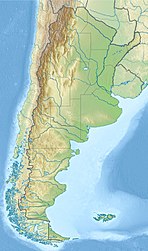Our website is made possible by displaying online advertisements to our visitors.
Please consider supporting us by disabling your ad blocker.
Salta Basin
| Salta Basin | |
|---|---|
| Cuenca Salta | |
| Coordinates | 23°40′S 66°07′W / 23.667°S 66.117°W |
| Etymology | Salta Province |
| Region | Argentine Northwest |
| Country | |
| State(s) | Salta, Jujuy, Tucumán Potosí Antofagasta |
| Cities | Salta |
| Characteristics | |
| On/Offshore | Onshore |
| Boundaries | Andes |
| Part of | Andean foreland basins |
| Geology | |
| Basin type | Foreland-on-rift basin or intracontinental rift basin |
| Plate | South American |
| Orogeny | Andean |
| Age | Neocomian-Neogene |
| Stratigraphy | Stratigraphy |
Salta Basin or Salta Rift Basin is a sedimentary basin located in the Argentine Northwest.[1][2] The basin started to accumulate sediments in the Early Cretaceous (Neocomian) and at present it has sedimentary deposits reaching thicknesses of 5,000 metres (16,000 ft). The basin contains seven sub-basins: Tres Cruces, Lomas de Olmedo, Metán, Alemanía, Salfity, El Rey, Sey and Brealito. The basin environment has variously been described as a "foreland rift" and an "intra-continental rift". The basin developed under conditions of extensional tectonics and rift-associated volcanism.[1]
Previous Page Next Page



